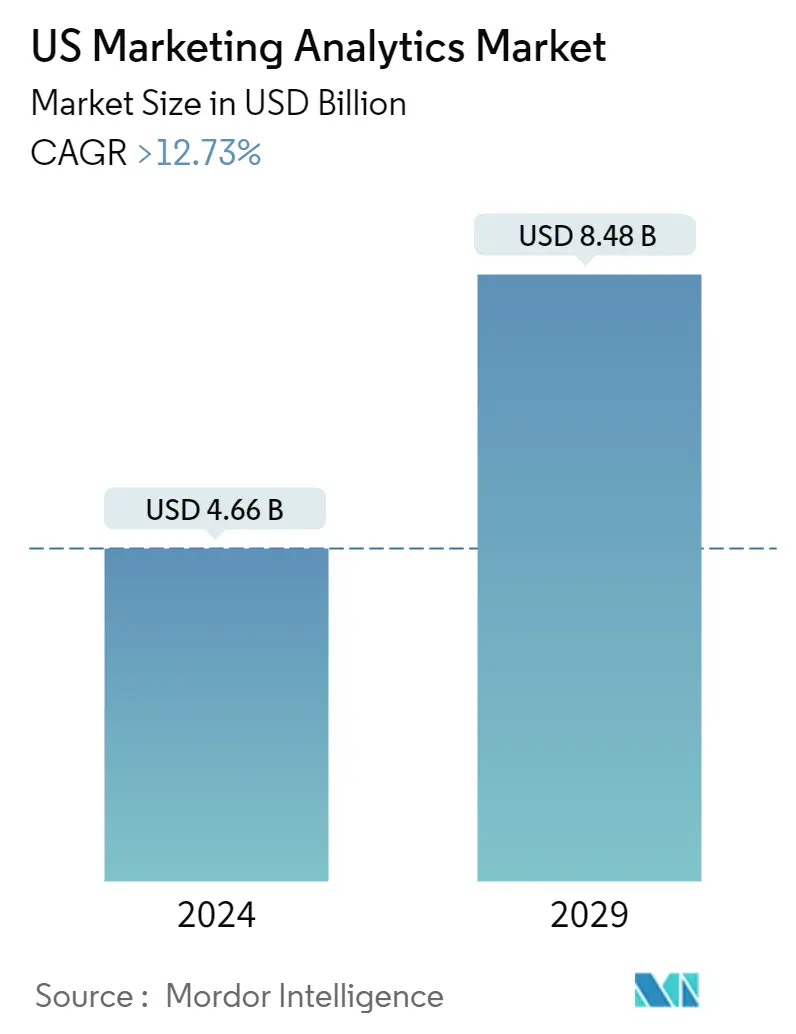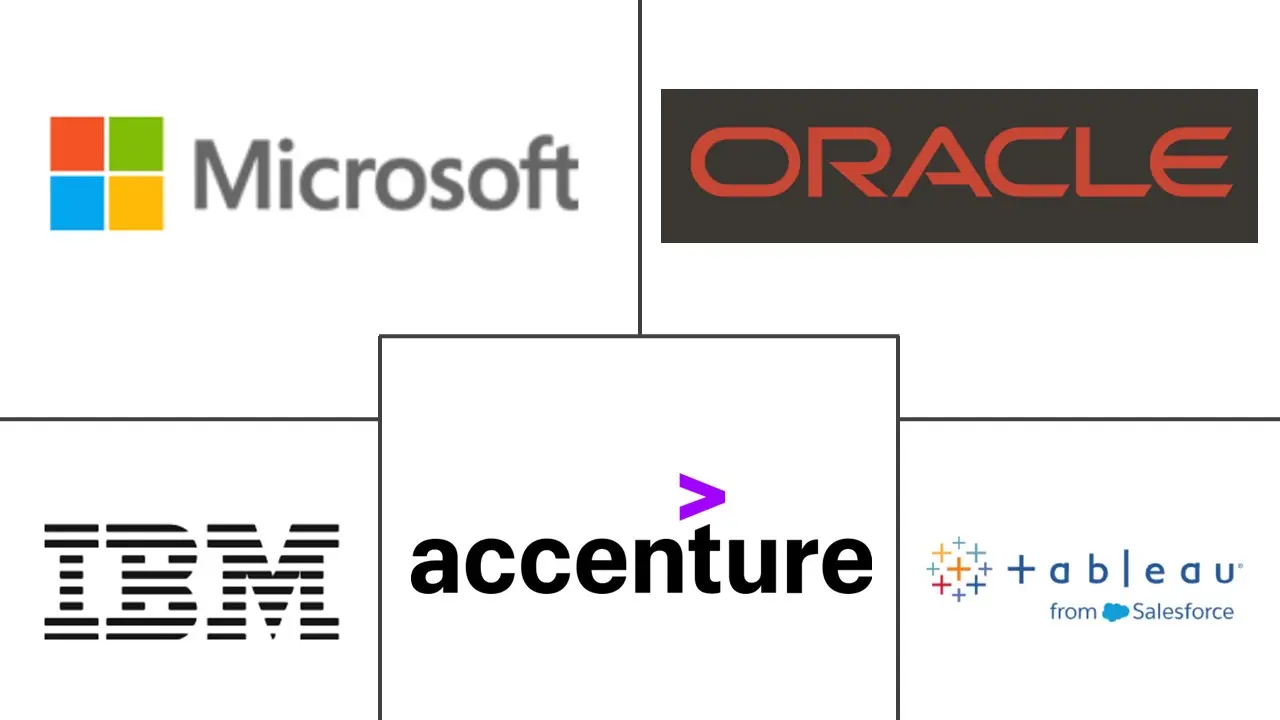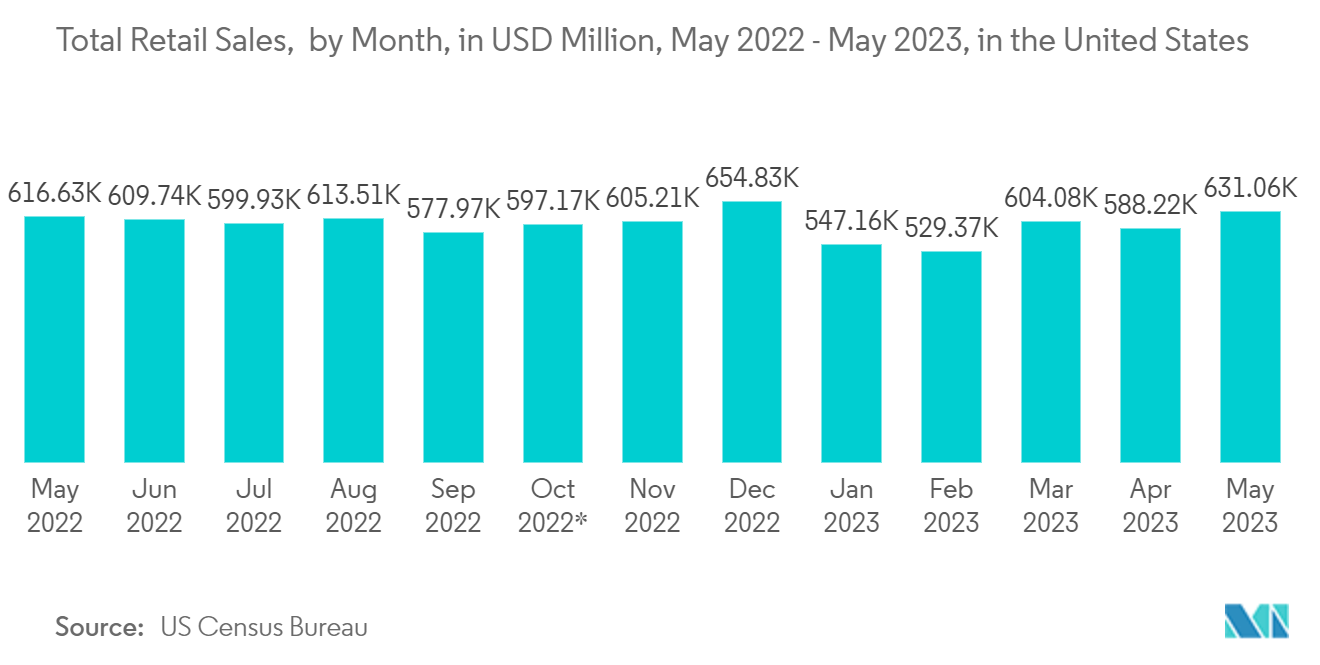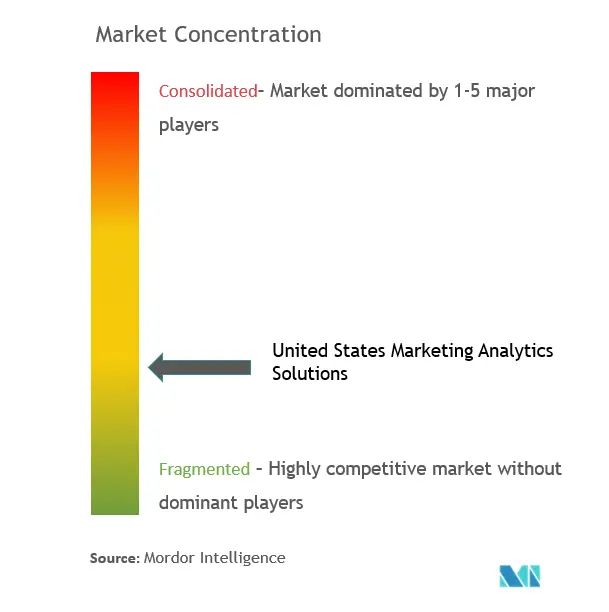US Marketing Analytics Market Size

| Study Period | 2019 - 2029 |
| Base Year For Estimation | 2023 |
| Market Size (2024) | USD 4.66 Billion |
| Market Size (2029) | USD 8.48 Billion |
| CAGR (2024 - 2029) | > 12.73 % |
| Market Concentration | Low |
Major Players
*Disclaimer: Major Players sorted in no particular order |
US Marketing Analytics Market Analysis
The US Marketing Analytics Market size is estimated at USD 4.66 billion in 2024, and is expected to reach USD 8.48 billion by 2029, growing at a CAGR of greater than 12.73% during the forecast period (2024-2029).
Companies increasingly realize the benefits of analytics in retaining customers and staying competitive. Businesses use multiple channels to keep customers informed and connected, and analytics solutions help track the impact of these actions. This has led to integrating analytics solutions with existing ERP systems, utilizing the generated data for better decision-making.
- Large businesses use web analytics and digital marketing tools to achieve an effective return on investment (ROI) and improve performance. Social media platforms also encourage marketers to invest in online marketing data analysis by monitoring, enhancing, and benchmarking their social media performance.
- The adoption of cloud technology and Big Data is also contributing to the growth of the marketing analytics market in the US. Cloud-based analytical tools are preferred as they are web-based, making hardware or software installation unnecessary. Advanced visualization techniques are being used to create comprehensive and user-friendly dashboards.
- In May 2023, Microsoft has announced Investment in AI Chatbots are finding their way into data analysis of USD 13 billion investment in OpenAI and its early efforts to integrate AI technology into Bing's search engine and other products such as email, word and excel, and Microsoft is rolling out a chatbot or Copilot that allows users to make sense of the information stored in corporate databases.
- The retail industry is a significant user of marketing analytics, particularly with the shift towards digital transformation and innovative store operations technologies. The need for actionable data is crucial in reducing asset loss at checkout, which can positively impact revenue and customer experience.
- In May 2022, Deep North, an intelligent video analytics company, launched Checkout IQ, its new retail loss prevention solution, to combat this issue. The solution uses computer vision and artificial intelligence (AI) to reduce shrinkage at checkout, empowering retailers with data-driven tools to remain competitive, maximize revenue, and offer great customer experiences. Deep North also announced a USD 16.7 Million Series A-1 funding, led by Celesta Capital and YobiPartners.
US Marketing Analytics Market Trends
Adoption of Cloud Technology and Big Data is Expected to Drive the Market Growth
- Cloud marketing is crucial to an organization's digital marketing strategy, leveraging various web-based technologies to promote goods and services online. This approach involves using online platforms, such as social media, websites, apps, emails, and more, to connect with potential customers and drive sales.
- For instance, businesses may run targeted advertising campaigns on social media sites like Facebook, Instagram, or Twitter as part of their cloud marketing plan. Additionally, cloud-based marketing platforms offer specific capabilities for digital marketing or online advertising, enabling businesses to manage their web marketing initiatives more effectively.
- One of the advantages of cloud marketing is that it allows businesses to leverage cutting-edge marketing data and analytics technologies. By moving their marketing data from local systems to the cloud, companies can track important data such as website visitors, views, likes, and shares. These indicators help businesses determine their campaigns' success and identify improvement areas. Moreover, companies can use cloud marketing automation software to automate their marketing efforts.
- Customized cloud infrastructure can also help manage daily traffic. In contrast, a strong hybrid cloud solution can handle traffic spikes during peak seasons like Christmas, Black Friday, Boxing Day, and free-shipping days. Cloud adoption in the retail industry is growing rapidly due to benefits such as inventory control, increased productivity, better control of customer data, and customized customer experience.
- In addition, advanced analytics, quick insights, and cloud strategies are transforming the digital landscape around personalized customer experiences, omnichannel networks, and agile supply chains. According to a study by IBM and Oxford Economics, a shift to cloud hosting environments is expected to gain traction for the retail sector, indicating promising trends in cloud adoption.
- In conclusion, cloud marketing is an effective approach for organizations looking to promote their goods and services online. By leveraging various web-based technologies, businesses can reach a wider audience, track important data, and automate their marketing efforts. As cloud adoption in the retail sector continues to grow, businesses embracing this technology will have a competitive edge over those not.

Retail is Expected to Register the Significant Growth Rate
- The retail industry in the United States is one of the largest in the world, with many of the world's biggest retailers headquartered there. Over the past two decades, total retail sales in the country experienced a significant increase, rising from just under three trillion dollars in 2000 to approximately 6.6 trillion dollars in 2021.
- While the coronavirus epidemic impacted conventional retail sales, nationwide lockdowns, and store closures fueled the growth of online retail. In the first quarter of 2022, e-commerce accounted for more than 14% of all US retail sales, nearly 4% more than during the same period in 2019. As a result, US e-commerce retail sales have experienced a recent surge, with the value of e-commerce sales in the nation climbing by over 487 billion dollars between 2016 and 2021. The rapidly growing data volume across in-store operations drives the market's growth.
- According to NewGenApps, retailers who leverage the full potential of big data analytics can optimize their operating margins by almost 60%. Additionally, omnichannel retailers can monitor in-store customer behavior and provide timely suggestions to incentivize in-store or later online purchases, thereby keeping the purchasing within the fold of the retailer. Due to these factors, adopting retail marketing analytics is expected to drive the market.
- Collecting and making decisions based on that data in the studied market is vital, particularly in the retail industry. Customers are directly responsible for retailers' success, making shopper experience and customer satisfaction high on the priority list, and customer and market research crucial. Customer data enables retailers to understand what drives purchase decisions, and the introduction of big data in retail enables retailers to curate more relevant, meaningful, and engaging customer experiences. It is also necessary for developing a successful business and marketing strategy.

US Marketing Analytics Industry Overview
The marketing analytics market in the United States is highly competitive, with several major players vying for market share. Currently, only a few of these players dominate the market. These industry leaders primarily focus on expanding their customer base domestically and abroad.
- September 2023 - Oracle added new artificial intelligence (AI) capabilities in Orcale Fusion cloud customer experience (cx)to help marketers, sellers, and service agents grow revenue and deliver exceptional customer experience. The latest AI capabilities liberate marketers, sellers, and service agents from time-consuming and manual tasks by unlocking relevant content, recommendations, and insights with automation and conversational interfaces.
- March of 2022 - LinkedIn significantly expanded its marketing solutions offering by acquiring Oribi, an Israeli marketing analytics startup. This acquisition will help LinkedIn explore new methods to assist businesses in profiting from its advertising and recruitment capabilities while improving performance across its platform. Oribi's analytics solutions provide businesses with an easier way to track and respond to events by emphasizing the crucial knowledge they need to act upon to benefit from performance trends.
US Marketing Analytics Market Leaders
-
IBM Corporation
-
Microsoft Corporation
-
Oracle Corporation
-
Salesforce.Com Inc.
-
SAS Institute Inc.
*Disclaimer: Major Players sorted in no particular order

US Marketing Analytics Market News
- June 2023 - Moody’s Corporation and Microsoft have announced a new partnership to deliver next-generation data, analytics, research, collaboration, and risk solutions for financial services and global knowledge workers. Built on a combination of Moody’s robust data and analytical capabilities and the power and scale of Microsoft Azure OpenAI Service, the partnership creates innovative offerings that enhance insights into corporate intelligence and risk assessment, powered by Microsoft AI and anchored by Moody’s proprietary data, analytics, and research.
- July 2022 - Neustar, a TransUnion company, announced a partnership with integrated data platform Adverity to allow marketers to connect all their data effortlessly to boost marketing and brand effectiveness. To better optimize marketing spending and boost return on investment (ROI), marketers need a comprehensive data strategy as data-driven marketing becomes more complex. Through this relationship, companies and agencies can more accurately assess the marketing effectiveness of various online and offline platforms, such as the walled garden and television ecosystems.
- December 2022 - Vi Labs, an Enterprise-AI for digital health, acquired Motus Consumer Insights, a member acquisition analytics, site selection, and marketing BI firm. Through the acquisition, Vi's robust AI-powered customer engagement and retention solution will be combined with the premier platforms for customer acquisition and site selection in the market. Vi's mission to use the power of data and AI to support people living active and healthy lifestyles worldwide is only accelerated by this deal.
US Marketing Analytics Market Report - Table of Contents
1. INTRODUCTION
1.1 Study Deliverables
1.2 Study Assumptions
1.3 Scope of the Study
2. RESEARCH METHODOLOGY
3. EXECUTIVE SUMMARY
4. MARKET INSIGHTS
4.1 Market Overview
4.2 Industry Attractiveness Porter's Five Forces Analysis
4.2.1 Threat of New Entrants
4.2.2 Bargaining Power of Buyers/Consumers
4.2.3 Bargaining Power of Suppliers
4.2.4 Threat of Substitute Products
4.2.5 Intensity of Competitive Rivalry
4.3 Industry Value Chain Analysis
4.4 Technology Snapshot
5. MARKET DYNAMICS
5.1 Market Drivers
5.1.1 Increase in Social Media Channels
5.1.2 Increasing Need to Utilize Marketing Budgets for an Effective ROI
5.1.3 Adoption of Cloud Technology and Big Data
5.2 Market Restraints
5.2.1 High Cost of Implementation and System Integration Issues for Marketing Analytics Software
5.2.2 Availability of Many Free Open Source Software
6. MARKET SEGMENTATION
6.1 By Deployment
6.1.1 Cloud
6.1.2 On-premise
6.2 By Application
6.2.1 Online Marketing
6.2.2 E-mail Marketing
6.2.3 Content Marketing
6.2.4 Social Media Marketing
6.2.5 Other Applications
6.3 By End User
6.3.1 Retail
6.3.2 BFSI
6.3.3 Education
6.3.4 Healthcare
6.3.5 Manufacturing
6.3.6 Travel and Hospitality
6.3.7 Other End Users
7. COMPETITIVE LANDSCAPE
7.1 Company Profiles
7.1.1 IBM Corporation
7.1.2 Microsoft Corporation
7.1.3 Oracle Corporation
7.1.4 Salesforce.Com Inc. (Tableau Software Inc.)
7.1.5 Accenture PLC
7.1.6 Adobe Systems Incorporated
7.1.7 SAS Institute Inc.
7.1.8 Teradata Corporation
7.1.9 Neustar, Inc.
7.1.10 Pegasystems Inc.
7.1.11 Google LLC
- *List Not Exhaustive
8. INVESTMENT ANALYSIS
9. MARKET OPPORTUNITIES AND FUTURE TRENDS
US Marketing Analytics Industry Segmentation
Marketing analytics software aid a company in tracking the data pertaining to traffic leads and sales. Implementing marketing analytics helps the person of interest compare various mediums of operation, such as social media vs. blogging vs. email marketing. These analytics also aid in diagnosing the difficulties faced in a particular channel and the tactical steps needed to improve the background.
The United States marketing analytics market is segmented by deployment (cloud-based and on-premise), application (online marketing, email marketing, social media marketing, content marketing, and other applications), and end-user (retail, BFSI, healthcare, manufacturing, travel and hospitality, and other end-users). The report offers market forecasts and size in value (USD) for all the above segments.
| By Deployment | |
| Cloud | |
| On-premise |
| By Application | |
| Online Marketing | |
| E-mail Marketing | |
| Content Marketing | |
| Social Media Marketing | |
| Other Applications |
| By End User | |
| Retail | |
| BFSI | |
| Education | |
| Healthcare | |
| Manufacturing | |
| Travel and Hospitality | |
| Other End Users |
US Marketing Analytics Market Research FAQs
How big is the US Marketing Analytics Market?
The US Marketing Analytics Market size is expected to reach USD 4.66 billion in 2024 and grow at a CAGR of greater than 12.73% to reach USD 8.48 billion by 2029.
What is the current US Marketing Analytics Market size?
In 2024, the US Marketing Analytics Market size is expected to reach USD 4.66 billion.
Who are the key players in US Marketing Analytics Market?
IBM Corporation, Microsoft Corporation, Oracle Corporation, Salesforce.Com Inc. and SAS Institute Inc. are the major companies operating in the US Marketing Analytics Market.
What years does this US Marketing Analytics Market cover, and what was the market size in 2023?
In 2023, the US Marketing Analytics Market size was estimated at USD 4.13 billion. The report covers the US Marketing Analytics Market historical market size for years: 2019, 2020, 2021, 2022 and 2023. The report also forecasts the US Marketing Analytics Market size for years: 2024, 2025, 2026, 2027, 2028 and 2029.
US ing Analytics Industry Report
Statistics for the 2024 US ing Analytics market share, size and revenue growth rate, created by Mordor Intelligence™ Industry Reports. US ing Analytics analysis includes a market forecast outlook 2029 and historical overview. Get a sample of this industry analysis as a free report PDF download.



